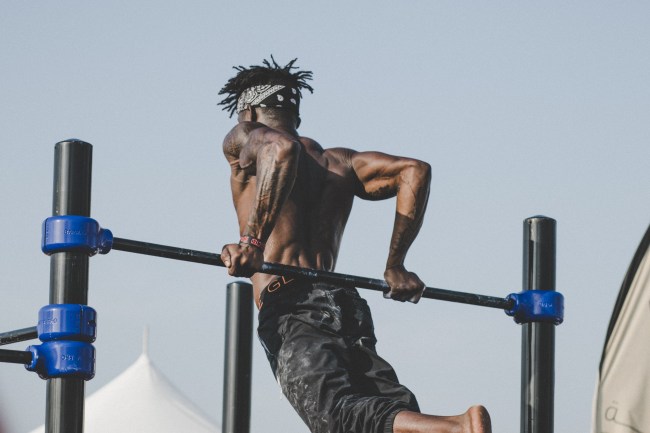
Photo by Keit Trysh on Unsplash
I went to go use the bench press this past Monday, only to be met with a line. The kind of line you run into at a packed amusement park. Sometimes I feel like there should be one of those fancy velvet ropes and bouncer because the wait to use the bench is so long.
This has become the case every single Monday, which I have to believe is due to the fact that Monday is International Chest Day. What if we didn’t have to wait in line though?
Functional training has been all the rage lately, yet no one seems to be able to define what exactly functional training is. Far too many people on the Internet sit around and debate semantics, when we all know that functional means something carries over to other aspects of life.
This is where reframing how we think about exercise becomes vastly important, and keeps us from waiting in line on International Chest Day.
What we do in the gym should not only make us look better, it should make us feel better, and perform better in all aspects of life. It should be functional. How do we make this happen? Think movement patterns, not exercises.
We have four basic movement patterns.
Push
Pull
Hinge
Squat
Everything we do can be distilled into one of those four movement patterns. A lunge is a version of squatting. A push-up is pushing. A pull-up is pulling. Deadlifting is a hip hinge.
Or, for a more functional view: picking things up off the floor is a hip hinge. Putting your suitcase in the overhead compartment is pushing. See the similarities?
Movements for better health?
It doesn’t take much to realize that most of us in the modern world are broken. We’ve got terrible posture, stomachs that make it hard to see our shoes, and chronic health problems most of our great grandparents rarely thought of.
At some point, most of us reach a breaking point and look to fix ourselves. We want to eat better, and we want to start working out. Without any clue that the workouts we’re doing might be causing more harm than good.
Postural problems run amok.
Take a look around right now. How many people do you see who could do to work on their posture? Pull their shoulders back a bit, open up their chests, and sit up straighter?
These sort of postural issues are the result of a lifetime worth of excessive pushing and too little pulling. It’s usually worse in men, because we’re obsessed with working out our mirror muscles.
Take terrible every day posture and add in too much sitting, and too much pressing in the gym. What do you get? A recipe for shoulder issues, terrible posture, and future lower back issues at some point or another.
Practice movements for strength.
Being strong gives you freedom. There’s a level of confidence that comes with knowing you can pick up a few hundred pounds off the ground. It has an impact on a man. It changes how you carry yourself.
What exercises are superior when it comes to helping you build strength, fix your posture, and give you confidence? The very same movements we’re talking about. Hip hinging, or deadlifting. Squatting. Pulling, or rows and pull-ups. Pressing, or bench presses and overhead presses.
What about arm day?
The days of training like a bodybuilder are over, unless of course, your goal is to be a bodybuilder.
Most people want to look great naked, feel strong, and not feel completely broken day in and day out.
Not coincidentally, this is what happens when training the main movements becomes your focus instead of arm day, chest day, etc.
We want to feel strong, drop some fat, and look better when the clothes come off. The main movements get us there faster than any body part split program can.
What about when it comes to fat loss?
Some of the most metabolically demanding moves known to man are compound lifts. Lifts that use more than one joint moving at a time, usually involving quite a bit of weight. What are some examples?
Squatting.
Deadlifting.
Bench press, overhead press
Row, pull-up
What do all of those also have in common? They mimic our four basic human movements. Training for strength and fat loss is also making you more functional in every day life.
How to start implementing the movements?
So you’re ready to ditch chest day, but don’t know where to start?
You only need about four days a week. I like to train two movements a workout, and repeat. This way I know I’m getting in more frequency and volume, which can bring on more strength and size gains.
For example: I like to train Monday, Tuesday, Thursday, and Friday.
On Monday and Thursday my workouts will primarily be pushing and pulling. This means lots of rowing and pressing variations. Dumbbell rows, pull-ups, overhead presses, and incline presses all get done. I always prefer to do more pulling than pushing though, to aid posture and shoulder health.
On Tuesday and Friday I’ll do more leg dominant work. Deadlifts, deadlift variations, squats, front squats, and lunges all get done.
This set up isn’t completely different than most bodybuilding style splits. Most of the exercises are the same, you just get a bit more freedom in organizing your workouts, and you get stronger because of it. Next Monday when the bench is taken, get some pulling done instead. Your posture will be better for it.